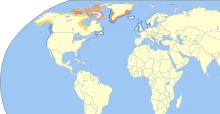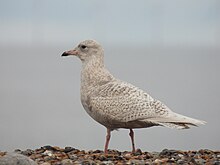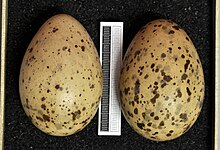
The common gull or sea mew is a medium-sized gull that breeds in the Palearctic. The closely related short-billed gull is sometimes included in this species, which may be known collectively as "mew gull". Many common gulls migrate further south in winter. There are differing accounts as to how the species acquired its vernacular name.

The laughing gull is a medium-sized gull of North and South America. Named for its laugh-like call, it is an opportunistic omnivore and scavenger. It breeds in large colonies mostly along the Atlantic coast of North America, the Caribbean, and northern South America. The two subspecies are L. a. megalopterus — which can be seen from southeast Canada down to Central America — and L. a. atricilla, which appears from the West Indies to the Venezuelan islands. The laughing gull was long placed in the genus Larus until its present placement in Leucophaeus, which follows the American Ornithologists' Union.
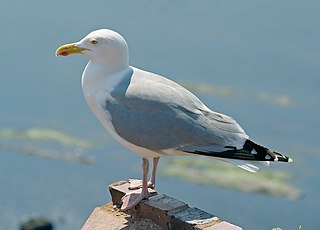
The European herring gull is a large gull, up to 66 cm (26 in) long. Common in coastal regions of Western Europe, it was historically more abundant. It breeds across Northern Europe, Western Europe, Central Europe, Eastern Europe, Scandinavia, and the Baltic states. Some European herring gulls, especially those resident in colder areas, migrate further south in winter, but many are permanent residents, such as in Ireland, Britain, Iceland, or on the North Sea shores. They have a varied diet, including fish, crustaceans, as well as some plants, and are also scavengers, consuming carrion and food left by or stolen from humans.

The great black-backed gull is the largest member of the gull family. Described by the Cornell Lab of Ornithology as "the king of the Atlantic waterfront", it is a very aggressive hunter, pirate, and scavenger. It breeds on the European and North American coasts and islands of the North Atlantic and is fairly sedentary, though some move farther south or inland to large lakes or reservoirs. The adult great black-backed gull has a white head, neck and underparts, dark grey wings and back, pink legs and yellow bill.

The lesser black-backed gull is a large gull that breeds on the Atlantic coasts of Europe. It is migratory, wintering from the British Isles south to West Africa. However, it has increased dramatically in North America, especially along the east coast. Formerly just a winter visitor to North America, it now occurs in large numbers some winters and many birds are now spotted year-round. The species has become an annual winter visitor in California, with birds reported around most of the state, including at the Salton Sea. There is now serious concern about decline in many parts of its range. The species is on the RSPB Amber List because the UK is home to 40 per cent of the European population and more than half of these are found at fewer than ten sites.

The glaucous gull is a large gull, the second-largest gull in the world. The genus name is from Latin larus, which appears to have referred to a gull or other large seabird. The specific name hyperboreus is Latin for "northern" from the Ancient Greek Huperboreoi people from the far north "Glaucous" is from Latin glaucus and denotes the grey colour of the gull. An older English name for this species is burgomaster.

Pallas's gull, also known as the great black-headed gull, is a large bird species. As is the case with many gulls, it has traditionally been placed in the genus Larus. The scientific name is from Ancient Greek. Ichthyaetus is from ikhthus, "fish", and aetos, "eagle".

The yellow-legged gull is a large gull found in Europe, the Middle East and North Africa, which has only recently achieved wide recognition as a distinct species. It was formerly treated as a subspecies of either the Caspian gull L. cachinnans, or more broadly as a subspecies of the herring gull L. argentatus. The genus name is from Latin Larus which appears to have referred to a gull or other large seabird, and the species name honours the German zoologist Karl Michahelles.

The Caspian gull is a large gull and a member of the herring and lesser black-backed gull complex. The scientific name is from Latin. Larus appears to have referred to a gull or other large seabird, and cachinnans means 'laughing', from cachinnare 'to laugh'.

Sabine's gull also known as the fork-tailed gull or xeme, is a small gull. It is the only species placed in the genus Xema. It breeds in colonies on coasts and tundra, laying two or three spotted olive-brown eggs in a ground nest lined with grass. Sabine's gull is pelagic outside the breeding season. It takes a wide variety of mainly animal food, and will eat any suitable small prey.

The ivory gull is a small gull, the only species in the genus Pagophila. It breeds in the high Arctic and has a circumpolar distribution through Greenland, northernmost North America, and Eurasia.

The California gull is a medium-sized gull, smaller on average than the herring gull, but larger on average than the ring-billed gull. It lives not just in California, but up and down the entire Western coast of North America, and has breeding ground inland. The yellow bill has a black ring.

The kelp gull, also known as the Dominican gull, is a gull that breeds on coasts and islands through much of the Southern Hemisphere. The nominate L. d. dominicanus is the subspecies found around South America, parts of Australia, and New Zealand. L. d. vetula is a subspecies occurring around Southern Africa.

The western gull is a large white-headed gull that lives on the west coast of North America and the Pacific Ocean. The western gull ranges from British Columbia, Canada, to Baja California, Mexico.
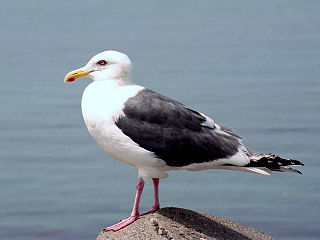
The slaty-backed gull is a large, white-headed gull that breeds on the north-eastern coast of the Palearctic, but travels widely during nonbreeding seasons. It is similar in appearance to the western gull and the glaucous-winged gull. Another alternate name is Pacific gull, though it also applies to a Southern Hemisphere species, L. pacificus.

The glaucous-winged gull is a large, white-headed gull. The genus name is from Latin Larus which appears to have referred to a gull or other large seabird. The specific glaucescens is Neo-Latin for "glaucous" from the Ancient Greek, glaukos, denoting the grey color of its wings.
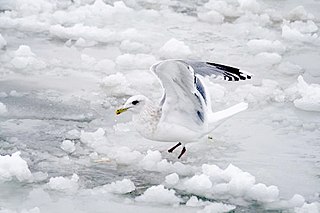
Thayer's gull is a subspecies of the Iceland gull. It is a large gull native to North America.
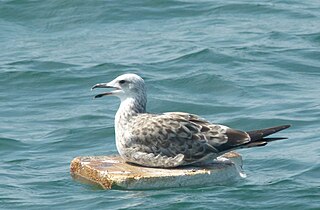
Heuglin's gull or the Siberian gull, is a seabird in the genus Larus.

Kumlien's gull is a subspecies of the Iceland gull. It is a large gull which breeds in the Arctic regions of Canada. It is migratory, wintering from Labrador south to New England and west across the Great Lakes. The subspecies is named after the naturalist Ludwig Kumlien. It is a regular vagrant in small numbers to Britain and Ireland.

The American herring gull or Smithsonian gull is a large gull that breeds in North America, where it is treated by the American Ornithological Society as a subspecies of herring gull.

